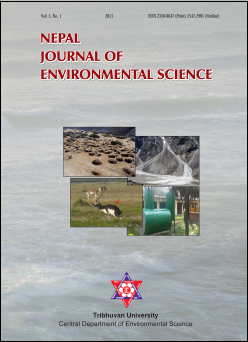Parasitic infection in blackbuck (Antilope cervicapra Linnaeus, 1758) of Blackbuck Conservation Area, Bardiya and Shuklaphanta Wildlife Reserve, Kanchanpur, Western Nepal
DOI:
https://doi.org/10.3126/njes.v5i0.22710Keywords:
Blackbuck, GI parasites, wildlife, Blackbuck Conservation Area, Shuklaphanta Wildlife ReserveAbstract
Blackbuck (Antilope cervicapra) is Near Threatened species which are conserved in blackbuck Conservation Area (BCA), Khairapur, Bardiya and Shuklaphanta Wildlife Reserve (SWR), Kanchanpur district. The present study was conducted to determine the parasitic infection in blackbuck of BCA and SWR. A total of 150 and 70 fresh faecal samples of blackbuck were collected from BCA and SWR respectively and examined by floatation, sedimentation and Stoll's counting technique. The overall prevalence of GI parasites was found to be 90.00%. The protozoan and helminthic parasitic prevalence revealed 55% and 89% respectively in both the study area. Blackbuck of BCA were found to be infected with 12 different species of parasites which includes Entamoeba sp. (20%) and Eimeria sp. (45.33%) among protozoa; Paramphistomum sp. (25.33%) and Fasciola sp. (17.33%) among trematodes; Moniezia sp. (14%) among cestode; Trichostrongylus sp. (75.33%), Ascaris sp. (57.33%), Haemonchus sp. (18%), Strongyloides sp. (16%), Bunostomum sp. (12.67%), Trichuris sp. (6%) and Oxyuris sp. (4.67%) among nematodes; while blackbuck of SWR were found to be infected with 10 different parasitic genera, i.e. Entamoeba sp. (8.57%) and Eimeria sp. (51.43%) among protozoa; Paramphistomum sp. (38.57%), Fasciola sp. (21.43%) and Schistosoma sp. (7.14%) among trematodes; Trichostrongylus sp. (55.71%), Ascaris sp. (38.57%), Haemonchus sp. (14.28%), Strongyloides sp. (12.86%) and Bunostomum sp. (2.86%) among nematodes. The present findings provide some baseline information on the parasitic burden in Blackbuck and help to formulate appropriate strategies to mitigate the endoparasitic problem of blackbuck in SWR and BCA.
Downloads
Downloads
Published
How to Cite
Issue
Section
License
This license enables reusers to distribute, remix, adapt, and build upon the material in any medium or format for noncommercial purposes only, and only so long as attribution is given to the creator.

